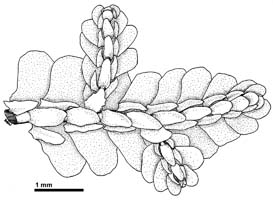Guide to Liverworts of Oregon: Porella roellii Steph.
HOME SPECIES INDEX GENUS INDEX GLOSSARY
Synonym: None
Special Status: None
Recognition: With large lobules and underleaves of approximately the same size, the genus is easily recognized with a hand lens. The peppery taste of this plant is absolutely diagnostic in our region. It is not like the taste of black pepper as used on the table, rather it produces a burning sensation on the tongue. No other species of Porella has this character. All that is necessary is to chew a centimeter of shoot tip in the front teeth of the mouth. Chewing with front teeth is critical because once a positive test is detected one will want to spit out the sample immediately because the burning increases with time even after the sample is expelled.
Distribution: Found both on tree trunks and on rocks with nearly equal frequency, absent from soil or decaying organic substrates. An endemic of the Pacific Coast of North America, frequent in western Oregon.
Comments: I first discovered the peppery taste of this species in 1976 and this lore has spread rapidly since then. Loren Russell gives an interesting account of the insect Caurinus dectes encounter with this species. It is a feeding specialist that eats liverworts almost exclusively in the wild. It feeds on P. navicularis with gusto but when offered P. roellii its reaction was similar to a human's: no effect for half a minute followed by backing off while wiping off mouth parts. After this experience, the insect refused P. navicularis when offered its preferred feed.
 Dry shoot in air, ventral aspect. North Fork Willamette River, Lane Co., Oregon. DHW sn. April 2008.
Dry shoot in air, ventral aspect. North Fork Willamette River, Lane Co., Oregon. DHW sn. April 2008.
 Branch, ventral aspect. Spencer Butte, Lane Co., Oregon. DHW
m1525
Branch, ventral aspect. Spencer Butte, Lane Co., Oregon. DHW
m1525
 Ventral aspect. Oregon. Mark Mahan 24 (ORE).
Ventral aspect. Oregon. Mark Mahan 24 (ORE).
 Shoot, ventral aspect. Andrews Forest, Lane Co., Oregon. DHW
1812
Shoot, ventral aspect. Andrews Forest, Lane Co., Oregon. DHW
1812
 Branched shoot, ventral aspect. North Fork Willamette River, Lane Co., Oregon. DHW sn. April 2008.
Branched shoot, ventral aspect. North Fork Willamette River, Lane Co., Oregon. DHW sn. April 2008.
 Branched shoot, ventral aspect. North Fork Willamette River, Lane Co., Oregon. DHW sn. April 2008.
Branched shoot, ventral aspect. North Fork Willamette River, Lane Co., Oregon. DHW sn. April 2008.